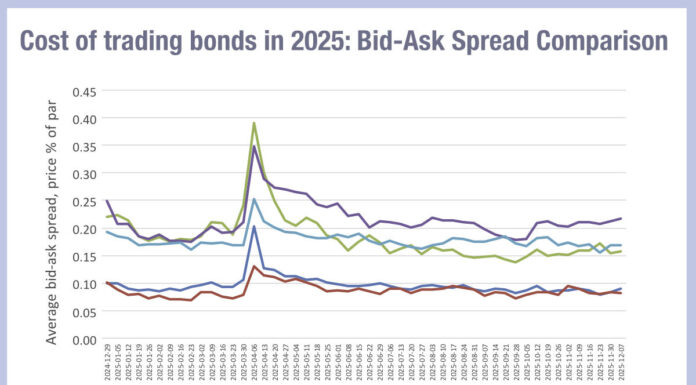The bank launches Digital Bond Issuances to better support investors as markets move to a distributed ledger model across assets.
As J.P. Morgan announces the release of its new Digital Bond Issuances in the US, Emma Lovett, markets DLT credit lead and Scott Lucas, head of markets DLT, share key insights into the value this is delivering to investors, now and in the future, the model to support risk reduction and competition in the space, and the best ways to get involved today.
How is distributed ledger technology going to change over the counter asset classes?
Scott Lucas: We’re using distributed ledger technology (DLT) to explore how to thoughtfully bring efficiency and, in the longer term, more trading opportunities to the fixed income market. Ultimately that will need cooperation and collaboration across the industry to get the necessary liquidity, and we plan to be part of that progress by providing a wider set of investment opportunities, making it accessible to more funds, and working with other dealers and custodians.

Emma Lovett: In bond markets, DLT should reduce the operational costs of managing and servicing funds. Today those costs regularly sit with settlement and operations teams, who navigate the complexities that arise from multiple participants in the process of maintaining independent ledgers, often using manual processes, including emails, etc. Blockchain offers the ability for every participant on a trade to access one single ledger, increasing transparency and reducing the need for reconciliation. This can be especially impactful when there are participants in different jurisdictions or time zones, which can add unwanted delay, and therefore cost, to any manual intervention.
How does it do that?
Emma Lovett: One example is the operational challenge around coupons. These are typically paid semi-annually or annually, requiring a very manual process. If parts of the process can be automated, one can efficiently change the frequency at which coupons can be paid, without increasing operational risk, therefore creating choice and a wider set of risk profiles for investors.
What is the platform?
Emma Lovett: The Digital Debt Service application uses the Onyx Digital Assets platform. The operating model for settlement and servicing was developed in conjunction with our Global Custody business. The operational lift for our mutual clients is small as a result. They need to onboard on to the platform, but beyond that, the intention is that the process to invest, settle, and hold these blockchain bonds is broadly aligned with the rest of their existing portfolio. That’s really important for our investors.
Why are investors getting involved?
Emma Lovett: Investors are interested as there is a broad recognition that this technology, developed the right way, can offer a better solution for fixed income securities – both from an asset servicing and trading standpoint. That doesn’t yet mean the future market will be DLT-based, as there is a lot of work for the market to transition in that direction. However, due to the opportunity, there are a number of investors actively looking to learn more about what that future might look like and how it may impact them.

Scott Lucas: A key factor to have investors engage on that journey is to keep the process aligned as much as possible with the current practice, keeping onboarding straightforward while still realising some new value. To access a bond you have to onboard to the Digital Debt Service on the Onyx Digital Assets platform, have access through your custodian, and accept the workflow process.
The process is exactly the same as it is now up to pricing, then all post-trade activity moves onto the Digital Debt Service application, which has a range of features and will be extended as we develop the platform further.
How will this evolve?
Scott Lucas: There are a number of platforms being developed which demonstrate and assess different aspects of what the technology can bring to the market. In order for wider adoption, the market needs to identify appropriate opportunities for partnership and collaboration to realise the most valuable aspects of each platform. From a J.P. Morgan standpoint we are exploring adding custodians to widen the investor base, and potentially further dealers. We are engaged with the existing market infrastructure providers also, as we see some opportunities for market improvements in that area as well.
©Markets Media Europe 2024
©Markets Media Europe 2025












